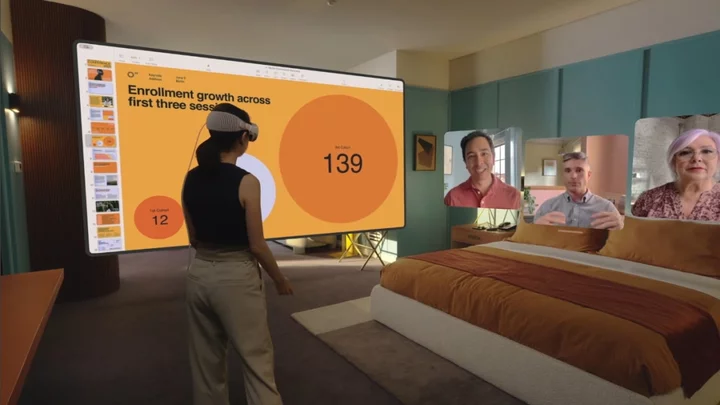The terms virtual reality and augmented reality get thrown around a lot. VR headsets, such as the Meta Quest 2 or the Valve Index, and AR apps and games, such as Pokemon Go, are popular. They sound similar, and as the technologies develop, they bleed into each other in some ways. This is readily apparent in the new Apple Vision Pro, a headset that won't go on sale until early 2024.
But VR and AR are still two very different concepts, with defining characteristics that distinguish one from the other.
What Is Virtual Reality?
Meta Quest ProVR headsets completely take over your vision to give you the impression that you're somewhere else. The PlayStation VR 2, the Meta Quest 2, the Valve Index, and other headsets are opaque, blocking out your surroundings when you wear them. If you put them on when they're turned off, you might feel as if you're blindfolded.
Top VR Headsets
Meta Quest 2 Review
4.5 Outstanding $299.00 at Amazon See It (Opens in a new window)Sony PlayStation VR2 Review
4.5 Outstanding $599.99 at Amazon See It (Opens in a new window)Valve Index VR Kit Review
4.0 Excellent $1,445.95 at Amazon See It (Opens in a new window)Meta Quest Pro Review
4.0 Excellent $999.99 at Amazon See It (Opens in a new window) See all (4 items)When the headsets turn on, however, the LCD or OLED panels inside are refracted by the lenses to fill your field of vision with whatever is being displayed. It can be a game, a 360-degree video, or just the virtual space of the platforms' interfaces. Visually, you're taken to wherever the headset wants you to go—the outside world is replaced with a virtual one—hence the name.
For both games and apps, virtual reality supersedes your surroundings. Where you are physically doesn't matter. In games, you might sit in the cockpit of a starfighter. In apps, you might virtually tour distant locations as if you were there. There are tons of possibilities in VR, and they all involve replacing everything around you with something else. This doesn't mean your surroundings are completely out of the picture, though; most current VR headsets are able to scan your surroundings or at least set boundaries to keep you in the area you've cleared to use them and not trip over your furniture.
Superhot VRWhat Is Augmented Reality?
While virtual reality replaces your vision, augmented reality adds to it. AR devices, such as the Microsoft HoloLens, the original Google Glass, and various enterprise-level "smart glasses," are transparent, letting you see everything in front of you as if you are wearing a pair of clear glasses.
The technology is designed for free movement while projecting images over whatever you look at. The concept extends to smartphones with AR apps and games, such as Pokemon Go, which use your phone's camera to track your surroundings and visually overlay additional information on top of it.
AR displays can offer something as simple as a text overlay that shows the time, to something as complicated as holograms of furniture floating in the middle of a room. Pokemon Go projects a Pokemon on your screen that rests on top of whatever the camera is pointed at. The HoloLens and other smart glasses, meanwhile, let you virtually place floating app windows and 3D decorations around you.
These displays tend to be expensive, however, and we've yet to see an AR headset both realistically priced and with enough features to be considered a true consumer product. Because of this, the majority of AR experiences available to most people are via smartphones—using your phone's camera and screen to augment your reality in a very limited view.
Augmented reality has nearly limitless possibilities. Phone-based AR software has been recognizing surroundings and providing additional information about what it sees for years now, offering live translation of text or pop-up reviews of restaurants as you look at them. Dedicated AR headsets, such as the HoloLens, can do even more, letting you virtually place different apps as floating windows around you. They effectively give you a modular, multi-monitor, computing setup. However, purely AR headsets are still too expensive and bulky to be considered everyday computing items.
The Middle Ground: Mixed Reality
AR and VR were mutually exclusive concepts at first, but slowly they've merged into a new catch-all range of reality-shifting technology: mixed reality. Sometimes called MR or XR, mixed reality is when primarily VR headsets incorporate AR aspects into their use.
Apple Vision ProAll major VR headsets currently available have outward-facing cameras that can scan your surroundings and provide a view of what's around you. Virtual reality becomes mixed reality when those surroundings factor into what you're doing in the headset. It can be as simple as setting borders around you so you don't trip over anything in the real world, or as complicated as taking detailed measurements of furniture and building the virtual environment to reflect those physical objects.
It's a broad term, and, ultimately, mixed reality can describe any part of the AR/VR spectrum, but we're seeing more and more of a firm middle ground between them. The Meta Quest Pro, for example, has color cameras that provide a much clearer view of your surroundings and project virtual screens on your desk, letting you work as if you had multiple monitors and even use your own keyboard and mouse instead of virtual representations of them. The upcoming Apple Vision Pro also appears to have these features, and will similarly display virtual objects across your real environment. Apple calls its product a Spatial Computer.
Effectively, though, both of these experiences are more VR than AR. Unless you're dealing with a transparent display that overlays information about an environment that you can look at directly, any headset is still going to completely determine what your eyes see, pixel by pixel. Pass-through video gives a taste of AR, but you're still wearing a VR headset.
Looking Towards the Future
The line between AR and VR won't be going away fully any time soon, but in the short term, it will become less defined as mixed reality becomes a bigger factor among VR headsets. Outward-facing cameras and environment-scanning technology will improve over time and you'll be able to get a clearer look at your surroundings when wearing a headset—effectively making every VR headset a mixed reality headset as well.
In the longer term, however, that line will probably become sharper once again. For the moment, processing requirements and display technology still limit how small and affordable AR displays can be. The electronics that go into AR glasses are still expensive and take up a fair amount of space. Once the components become small enough to install on a pair of glasses without significantly adding to its heft, and are relatively inexpensive, dedicated AR displays will pull away from full vision-covering VR headsets and really bring the augmented reality concept into a consumer-friendly reality. For now, your choices are big goggles or staring at your phone.









